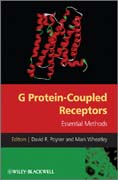
G-Protein Coupled Receptors (GPCRs) are not only the largest protein family in the human genome but are also the single biggest target for therapeutic agents. Research into GPCRs is therefore growing at a fast pace and the range of techniques that can be applied to GPCRs is vast and continues to grow. This book provides an invaluable bench-side guide into the best and most up-to-date techniques for current and future research on GPCRs. With contributions from leading international authorities, this book equips readers with clear and detailed protocols for both well-known and up-and-coming techniques along with hintsand tips for success. All the methods have been tried and tested by leading international research labs and are presented in easy-to-follow stages along with a useful overview of each technique. This book is an essential resource forall researchers in molecular biology, biochemistry, pharmacology and for graduate students. INDICE: Preface. List of Contributors. 1 Measurement of Ligand-G-protein-coupled Receptor Interactions Using Radioligand Binding Techniques (Katie Leach, Celine Valant, Patrick M. Sexton and Arthur Christopoulos). 1.1 Introduction. 1.2 Methods and Approaches.. References. 2 Second Messenger Assays for G-protein-coupled Receptors: cAMP, Ca2+, Inositol Phosphates, ERK1/2 (Karen J. Gregory, Patrick M. Sexton, Arthur Christopoulos and Caroline A. Hick). 2.1 Introduction. 2.2 Methods and Approaches. 2.3 Troubleshooting. References. 3 Use of the [35S]GTPgS Binding Assay to Determine Ligand Efficacy at G-protein-coupledReceptors (Elodie Kara and Philip G. Strange). 3.1 Introduction. 3.2 Methods and Approaches. 3.3 Troubleshooting. Acknowledgements. References. 4 Quantitative Imaging of Receptor Trafficking (Andy R. James, Takeo Awaji, F. Anne Stephenson and Nicholas A. Hartell). 4.1 Introduction. 4.2 Methods and Approaches. 4.3 Troubleshooting. References. 5 Production of Recombinant G-protein-coupledReceptor in Yeast for Structural and Functional Analysis (Richard A.J. Darby,Mohammed Jamshad, Ljuban Grgic, William J. Holmes and Roslyn M. Bill). 5.1 Introduction. 5.2 Methods and Approaches. 5.3 Troubleshooting. References. 6 Monitoring GPCR-Protein Complexes Using Bioluminescence Resonance Energy Transfer(Werner C. Jaeger, Kevin D.G. Pfleger and Karin A. Eidne). 6.1 Introduction. 6.2 Methods and Approaches. 6.3 Troubleshooting. References. 7 Using Intramolecular Fluorescence Resonance Energy Transfer to Study Receptor Conformation (Cornelius Krasel and Carsten Hoffmann). 7.1 Introduction. 7.2 Methods and Approaches. 7.3 Troubleshooting. References. 8 A Disulfide Cross-linking Strategy Useful for Studying Ligand-induced Structural Changes in GPCRs (Jian Hua Li, Stuart D.C. Ward, Sung-Jun Han, Fadi F. Hamdan and Jurgen Wess). 8.1 Introduction. 8.2 Methods and Approaches. 8.3 General Considerations, Caveats and Troubleshooting. Acknowledgements. References. 9 Use of Fluorescence Correlation Spectroscopy to Study the Diffusion of G-protein-coupled Receptors (Stephen J. Briddon, Jonathan A. Hern and Stephen J. Hill). 9.1 Introduction. 9.2 Methods andApproaches. 9.3 Measuring the Diffusion of a Ligand-occupied GPCR. 9.4 Data Analysis. 9.5 Troubleshooting. References. 10 Identification and Proteomic Analysis of GPCR Phosphorylation (Kok Choi Kong, Sharad C. Mistry and Andrew B. Tobin). 10.1 Introduction. 10.2 Methods. Acknowledgements. References. 11 Measurement and Visualization of G-protein-coupled Receptor Trafficking by Enzyme-linked Immunosorbent Assay and Immunofluorescence (Stuart J. Mundell, Shaista P.Nisar and Eamonn Kelly). 11.1 Introduction. 11.2 Methods and Approaches. 11.3Troubleshooting. References. 12 Substituted Cysteine Accessibility Method (SCAM) (George Liapakis and Jonathan A. Javitch). 12.1 Introduction. 12.2 Methodsand Approaches. 12.3 Troubleshooting. References. 13 Homology Modelling of G-protein-coupled Receptors (John Simms). 13.1 Introduction. 13.2 Methods and Approaches. 13.3 Troubleshooting. 13.4 Automated Methods for Generating Models of GPCRs. References. Appendix: Site-directed Mutagenesis and Chimeras (Alex Conner, Mark Wheatley and David Poyner). A.1 Introduction. A.2 Why Mutagenesis?.A.3 Troubleshooting. A.4 Conclusion. References.
- ISBN: 978-0-470-74914-2
- Editorial: John Wiley & Sons
- Encuadernacion: Cartoné
- Páginas: 312
- Fecha Publicación: 11/12/2009
- Nº Volúmenes: 1
- Idioma: Inglés
